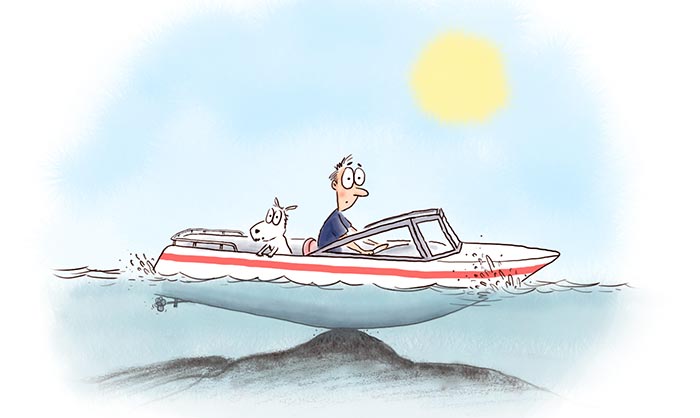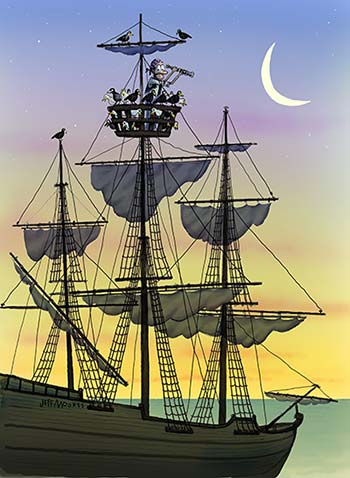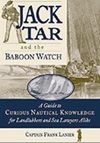Ship Shape in Bristol Fashion Lady Captains of Captain Bree
Nautical Word Origins: All Shipshape & Bristol Style
The roots of many phrases and words we utilize every day tin be traced to a life adrift. Here'southward a smattering of nautical sayings that have come ashore over the years.

Illustrations: Jeffrey Moores
A cup of Joe
The nickname for coffee came about due to the reforms initiated in 1913 by Josephus Daniels, so secretarial assistant of the United states Navy under President Woodrow Wilson. One such reform was the elimination of the officers' wine mess, a policy received less than enthusiastically by many. Since that fourth dimension a cup of the strongest drink allowed on board U.S. naval ships has been referred to as "a cup of Joe."
Bigwigs
Strangely plenty, this is one bit of seafaring lingo that pretty much means what it says. Senior officers of Great britain'south Royal Navy at i time really did wear bodaciously big wigs after the manner of the solar day.

Homemade
This term for the smuggling of illegal liquor was derived from the sailors' ruse of bringing in contraband by hiding information technology in the tops of the sea boots.
Comport a bone in her teeth
Phrase used to draw a ship sailing fast enough to cream the water in front of her bow.
Crow'southward nest
Name for the highest lookout man station aloft, a term most probable derived from the old Norse practice of bringing cages of ravens aboard to assistance in navigation. If the navigator was in dubiousness as to the direction of the nearest landfall, the muzzle was hoisted aloft, and a raven released. The bird invariably headed for land, the navigator noted the direction of flight, and plotted accordingly. Best gauge is the picket stationed aloft probable shared his perch with the feathered members of the crew from time to fourth dimension, thus the name!
Duffel
A sailor's personal belongings (normally referring to his clothing) as well as the ocean handbag of coarse woolen fabric used to carry and stow them in. The name probably originated from the Flemish town of Duffel (near Antwerp) where the cloth was made.
Footloose
Uninhibited or spontaneous. The bottom of a triangular sail is called the foot, and a "loose-footed sail" is one fastened fore and aft, but unsecured along the boom itself and able to dance freely in the wind if the clew (aft end) is freed.
Dungaree
Webster's Dictionary once defined dungaree every bit "a fibroid kind of material worn by the poorer class of people and besides used for tents and sail." While we probably couldn't picture our favorite pair of jeans hanging from the yardarm, discarded sailcloth (which was not dyed bluish, nor was likewise-woven equally today's fabric) was ofttimes utilized past sailors to brand items such as piece of work wearing apparel and hammocks. In fact, it was standard practice for captains in both the American and British navies to exaggerate the amount of sail lost during a battle in order to provide the crew with material. The cloth was chosen dungaree (from the Hindi word dungri), and the name became synonymous with the clothes themselves.
Gamming
A "gam" was a mutual visit between the crews of whaling ships when they happened to meet abroad. It was in that location the latest news and gossip was exchanged and yarns were spun amid plenty of song, dance, food, and drink. The word "gam" came from whaleman slang for a pod of whales.
Difficult upwardly
Destitute, fallen on difficult or trying times, this is derived from "difficult up the helm," an guild to place the tiller every bit far to windward as possible during difficult weather, thus turning the ship's head abroad from the wind so she might ride easier.
Simply Why Is It Called The 'Head'?
The forward-nearly part of the ship was originally known equally the "bows" or "beakhead" later the ram on the bow of a fighting galley (think beak as in bird of prey). During the Medieval period, the bows evolved into a raised castle-like structure from which archers (and later fighting musketeers) could burn down upon the enemy during battle, which is where the name forecastle (or fo'c'sle) is derived.
Over time, the forecastle devolved into basically a work platform covered with open grating. Due to the continuous flushing action of the sea and its location (which allowed the wind coming forward to carry the smell forward, too, away from the ship), this is where the lavatories or "seats of ease" came to be located, these being goose egg more than benches built over holes cut into the grating.
Those who used them were fully exposed to both the elements and the ship's company with at to the lowest degree one Spanish traveler describing with mock sentiment the lovely views afforded the crew of the moon and planets, as well every bit the tarred ropes (which serve the aforementioned purpose as the corncob in rural America) and those impromptu washings provided past the waves. Thoughtful captains frequently had safety netting strung around the unabridged area, equally it was non uncommon for patrons caught off guard to exist washed overboard by larger seas. They could be busy places besides, as a typical 18th century human being-of-state of war possessed only six seats of ease for a crew of roughly 800.
Hunki dori
Commodore Matthew Perry's celebrated visit to Nihon in July 1853 began an era of openness and commercial intercourse between east and w. Yokohama was one of Japan's busiest ports at the time, and the principal street of the waterfront commune, Honki-dori, became famous for its power to provide an abundance of pleasures to sailors while in port.
While Honki-dori was relatively straightforward and easy to navigate, the winding side streets and back roads were not only confusing just potentially dangerous to unwary sailors (especially those of the inebriated persuasion) who often cruel victim to robbery or worse. Advice was if you stayed on Honki-dori you could probably find everything you desired in relative safety, hence the street proper noun association with everything being OK.

Know the ropes
Ane requirement of shipping aboard as an able seaman (versus an ordinary hand) was a thorough knowledge of all ropes pertaining to the vessel's functioning, which on a square-rigger could equate to miles of cordage. Crew members achieving that level of skill were said to "know the ropes."
Lubber Line
A line marked on a send'due south compass that's aligned with the vessel'south centerline and used as a reference bespeak showing the management straight ahead. Even the greenest hand on board could be instructed on how to steer a course by just keeping the lubber line on the right heading.
Posh
The belatedly 19th and early on 20th centuries witnessed the birth of the golden historic period of travel. Huge, opulent luxury liners began crossing the globe, all constructed to provide the wealthy of the day a means of traveling virtually in style — meals equal to the world's finest hotels, orchestras for dancing, a small regular army of stewards to wait on passengers hand and foot. I perk bachelor for those willing to shell out a little actress was found aboard the P&O steamship line, a major aircraft company of the day serving People's republic of china and India. Well-heeled travelers always requested the libation cabins located on the shady side of the send while crossing the Indian Ocean, cabins that P&O charged a premium for in improver to the already substantial fare.
Every bit port was the shady side on the outbound leg (with starboard being the sought-after side on the return or inboard portion of the trip) passengers who requested such cabins had the letters POSH (port outward, starboard homeward) printed on their tickets, introducing a new word for elegant or fashionable into the English.
Scuttlebutt
The scuttlebutt was a small cask (called a "butt") of water placed on deck each twenty-four hour period for members of the coiffure to beverage from, unremarkably past dipping a chained tin mug through a minor hole, or scuttle, cut into the barrel's side. The men could drink as often as they liked merely were allowed simply ane cup per trip to conserve water. Another conservation practice was doing away with the scuttle entirely, with the crew drinking from the cask via an sometime musket barrel shoved through the bung.
Equally racket had to exist kept to a minimum on deck (so commands and orders could be heard) and belowdecks as well (where off-watches were trying to sleep), the scuttlebutt was i of the few common areas where a sailor could relax while mulling over the mean solar day's events with fellow Tars. As such, the discussion itself somewhen came to mean "rumors" or "gossip."
Square repast
A solid, hearty meal said to exist derived from the square wooden platters hot meals were served upon aboard ship in good conditions.
Toe the line
Sailors called to muster were told past the bosun to "toe the line," significant they were to class up in a directly line, toes to one of the send'southward deck seams.
Bear upon and get
Often used to draw a catchy or delicate situation, this phrase refers to a send touching lesser with her keel but existence able to go along without grounding solidly. It especially highlights those suspenseful few seconds all boat owners feel at some point — that flow of alternating curses and prayers between touching bottom and reaching the safe of deeper water.
Windfall
Used to describe an unexpected stroke of skillful fortune, this is another popular term that has its roots in nautical language. During U.k.'s emergence as a growing naval power, the crown proclaimed all standing trees of a certain size located inside His Majesty'due south realm belonged to the Admiralty to ensure an adequate supply of wood for shipbuilding. Landowners were forbidden to affect trees so designated. However if i was blown downwardly via an act of God, the owner was free to claim and use this wind fall as he saw fit.

These snippets were excerpted with permission from "Jack Tar and the Baboon Spotter: A Guide to Curious Nautical Knowledge for Landlubbers and Sea Lawyers Alike" by our ain BoatUS Magazine contributing editor, Frank Lanier. Click here to purchase a copy.
Writer
Frank Lanier
Contributing Editor, BoatUS Magazine
Capt. Frank Lanier is a SAMS® Accredited Marine Surveyor with more than than 40 years of feel in the marine and diving industry. He'southward also an author, public speaker, and multiple award winning journalist whose articles on seamanship, marine electronics, vessel maintenance, and consumer reports appear regularly in numerous marine publications worldwide. He tin can be reached via his website at captfklanier.com.
BoatUS Magazine Is A Benefit Of BoatUS Membership
Membership Benefits Include:
-
Subscription to the print version of BoatUS Mag
-
iv% back on purchases from West Marine stores or online at WestMarine.com
-
Discounts on fuel, transient slips, repairs and more at over 1,200 businesses
-
Deals on cruises, charters, car rentals, hotel stays and more…
-
All for only $25/year!
0 Response to "Ship Shape in Bristol Fashion Lady Captains of Captain Bree"
Post a Comment